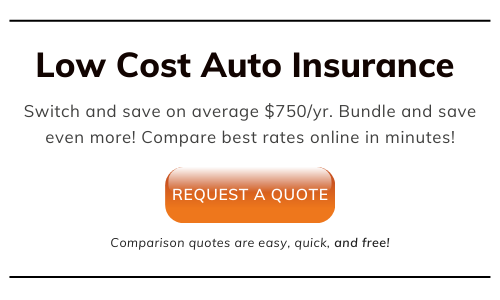How Much Is Car Insurance in 2025?
The first thing that comes to mind when purchasing a new vehicle may not be, “How much is car insurance going to cost me?” Still, it’s an important consideration.
To answer this and other related questions, it’s essential to accurately understand how insurance companies calculate their rates.
The method through which they do this is called actuarial math, and carriers will give varying weight to different factors when calculating your cost.
This is the reason for the considerable variations in insurance rates for the same coverage between competing companies.
Several sources can give you a birds-eye view of average insurance costs in your area.
Conducting research is a necessary step if you want to choose an insurance provider that meets both your coverage needs and your budget. It also helps to understand that many variables can either increase or decrease your quoted rate.
Knowing what these elements allow you to ask the right questions and secure a reasonable price.
The information below can show you exactly what goes into determining car insurance rates and provide advice on how to secure the best price.
Average Cost Of Car Insurance in 2021
Several reputable sources have information about insurance costs available to the public.
These include the National Association of Insurance Commissioners, the Department of Motor Vehicles, and state-based insurance departments.
Find the most up-to-date information regarding the average cost of car insurance from the sources below.
According to the 2017 report by the National Association of Insurance Commissioners, the cost of car insurance throughout the country saw an increase of about $100 between 2011 and 2015.
| Average Cost of Car Insurance in 2017 | $908.43 |
| Average Cost of Car Insurance in 2018 | $924.45 |
| Average Cost of Car Insurance in 2019 | $950.92 |
| Average Cost of Car Insurance in 2020 | $981.77 |
| Average Cost of Car Insurance in 2021 | $1,009.38 |
You may ask yourself, how much is car insurance on a state by state basis? Keep in mind that rates vary quite a bit from between states.
Many local factors can influence price, including weather and traffic conditions, accident rates, and crime rates. Each state outlines the minimum insurance amount drivers must carry, and both these minimums and the required coverage types fluctuate from state to state.
On top of that, states and insurance providers prioritize certain factors differently when considering insurance rates, which explains why there is such a significant variation in insurance prices.
Below are several recent examples from the DMV.org based on specific scenarios.
California
The DMV shows the following average annual premiums, as reported to the California Department of Insurance by 51 of California’s insurance providers.
Single Female
- Nine to 15 years driving experience
- One traffic violation
- Drives 12,000 to 15,000 miles per year
Average cost: $927.29
Single Male
- Nine to 15 years driving experience
- One traffic violation
- Drives 12,000 to 15,000 miles per year
Average cost: $929.74
Married Couple
- One traffic violation
- Each person drives about 12,000 to 14,000 miles per year
Average cost: $1,423.69
Florida
The DMV bases the following average insurance costs on Florida’s minimum insurance requirements, according to the Florida Office of Insurance Regulation’s CHOICES: Auto Rate Comparison Tool.
Single Female
- 25 years old
- One traffic violation
- One no-fault accident
- Drives 12,000 miles per year
Average cost: $1,364.72
Married Couple
- Both are 50 years old
- They have a 20-year-old son and an 18-year-old daughter
- Two cars
- No traffic violations
Average cost: $3,027.23
Texas
The DMV bases these calculations on rates reported by 56 insurance providers to the Texas Department of Insurance.
The calculations are for the minimum insurance requirements in Texas using the department’s online premium comparison tool.
Single Male
- Age 25 to 64 years
- One traffic violation
- Drives to and from work
- Average credit rating
Average cost: $888.50
Single Female
- Age 25 to 64 years
- One traffic violation
- Driving mostly to and from work
- Average credit rating
Average cost: $838.75
Massachusetts
The following average car insurance rates are based on the premiums reported by car insurance companies in Massachusetts, according to the Massachusetts Department of Consumer Affairs and Business Regulation’s Auto Insurance Premium Comparisons.
Single Driver
- Unmarried
- Licensed 14 years
- Drives a 2008 sedan
- Policy meets the minimum requirements of the state of Massachusetts
Average cost: $600.58
Married Drivers
- One licensed 14 years, the other licensed 12 years
- Each owns a car
- They commute to and from work
- One traffic violation between them
- One traffic accident between them
- Their policy includes higher-than-required liability and comprehensive insurance
Average cost: $1,667.31
As you can see, the varying factors of geographical location and driving history result in drastically different answers to the question of the cost of car insurance.
3 Factors That Affect How Much Car Insurance Costs

Many factors go into determining your insurance rates, and each one of these factors has an accompanying risk element.
Your insurance company has underwriters that perform complex calculations to assess the risks associated with insuring you and your car. Below are three factors that underwriters look at frequently.
1. Location
When it comes to calculating the cost of your insurance policy, your location plays a huge role, particularly when taking into account things such as traffic density and accident rates.
Providers also look at regional characteristics, including weather trends, theft rates, and driving conditions.
Anything about your geographical location that can increase the chances of you filing a claim will also cause your premiums to go up.
2. Credit Report
A low credit score equates a higher risk, due to the likelihood that your payments may arrive late or not at all. If you have a low to moderate credit score, you are likely paying a higher price for your auto insurance.
If you have no rating at all or an incredibly low score, there’s a chance you won’t even be able to obtain coverage.
Three states have disallowed the use of credit scores in determining auto insurance premiums: California, Massachusetts, and Hawaii. (For more information, read our “Cheap Car Insurance in Hawaii“).
If you are looking for a new insurance provider or have just purchased a new vehicle and are wondering, “How much is car insurance?,” run a recent credit report, and if necessary, work on increasing your score.
3. The Vehicle You Drive
Insurance companies perform risks analyses using details about the car you’re driving including its make, model, and trim style.
Your vehicle’s safety ratings, overall replacement value, condition, and associated theft rates all go into the mix as well. If your car has poor safety test results or has unusually high theft rates, your insurance cost can go up.
The value of your vehicle is also directly related to your insurance rate. The more your car is worth, the higher its insurance premiums.
Read More: Here’s Why Your Car Insurance Is So High
How to Reduce the Cost of Your Car Insurance
Car insurance is always going to be an ongoing expense; it’s vital if you want to avoid paying out of pocket for hefty medical and repair bills after an accident.
It protects you and your passengers from financial hardship, whether you’re at fault in an accident or not.
However, the Insurance Information Institute recommends several actions you can take to try and reduce your insurance rate.
- Reduce coverage on older vehicles – if the value of your car is less than ten times the cost of your policy, evaluate your coverage
- Identify and report all safety features on your vehicle to your provider – this can garner you some discounts
- Bundle your home, auto, life, and health insurance
- Raise your deductible – while this means a lower monthly payment, it also means that your out of pocket costs will be higher in the event of an accident
- Take advantage of all the offered discounts – take the time to ask what discounts are available
Many of the top insurance companies in the United States offer rate discounts to their customers for items such as safe driving, remaining accident-free, paying their policy in full, and maintaining good grades in school (students).
When you’re ready to purchase your car insurance, make sure to keep the following information on hand, so you get an accurate quote that’s inclusive of all the discounts your insurance provider has available:
- Vehicle information for all vehicles on your insurance policy, including VIN, make, model, condition, year, and overall value
- Household information such as your complete address, details of where you park your car, the assets you need to insure, and your budget
- Data for all drivers in your household including their full name, date of birth, driving record, and school grades if they’re attending school
What Can Increase the Cost of Your Car Insurance?
Just as there are discounts and changes you can make to your policy to reduce the cost of your insurance, there are also elements that can increase your monthly rates. While some of these, such as your age and gender, are out of your control, there are steps you can take to help reduce the effect these factors have on the price of your insurance.
Some elements that contribute to increased rates include:
Traffic Violations
Traffic violations such as speeding tickets, driving without valid insurance, and driving under the influence can all contribute to higher insurance rates. In more severe cases, drivers with multiple infractions on their record may be denied insurance or have their license or vehicle registration suspended.
The best way to minimize the effect your driving record has on your insurance rates is to obey traffic laws. If you receive a ticket or fine, make sure to contest it in court when warranted, and take any necessary classes to reduce your penalty or remove it from your record.
Driver Age and Experience
Newly licensed teen drivers are often heard wondering, “Just how much is car insurance going to cost me?” Inexperienced drivers and teen drivers are always a higher risk to insurance companies. Similarly, senior drivers are thought to be high risk, due to their accident rates and susceptibility to health issues. Having teen drivers complete defensive-driving courses and having senior drivers take regular physical examinations and eye tests can help to reduce the effect this factor has on your insurance premium.
Vehicle Make and Model
As mentioned earlier, the make and model of your vehicle have a significant influence on your insurance rate.
Driving a car with high theft rates, a high overall value, or low safety ratings can increase the cost of your insurance drastically. When you’re shopping for a new vehicle, search for one that is less expensive, infrequently targeted by thieves, and highly rated by the NHSTA or IIHS in safety studies.
If you can find a car with plenty of advanced safety features, you may be able to minimize the effect that the make and model have on the cost of your insurance.
Now that you’ve read the above information, you should have a better answer to the question, “How much is car insurance?” and have a good idea of how insurance companies calculate rates.
The best way to find a good policy at a reasonable cost is with a little background research and comparison shopping.




